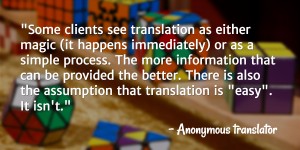Greater than 6 minutes, my friend!
Hire a Professional Translator by Starting out on the Right Foot
 Finding a translator – or rather, a service provider willing to translate your content – in today’s world is most definitely easier than it was in the past.
Finding a translator – or rather, a service provider willing to translate your content – in today’s world is most definitely easier than it was in the past.
Hiring the ‘right’ professional translator for a job is where the struggle still remains, but the truth is, many of the difficulties that usually arise can be avoided before you even send out an enquiry to a professional translator.
How?
The simple answer – provide as much information and detail as is possible.
But what information? What details?
That’s what I’ll outline below.
How to hire a professional translator by enquiring like a pro
By including the job details that translators desire most when considering new enquiries, you’ll be starting out on the right foot – allowing the translator to quickly decide if they’ll be the best fit for your job or not. This saves them, and you, a lot of unnecessary back-and-forth, headache, and ensures that both parties will be happy with the work arrangement you establish.
The following points come from key insights we learned from the survey results of 247 professional translators who described the types of crucial information that is either missing or poorly communicated in the most problematic of job enquiries.
Budget and Pricing
Talking about pricing can be a touchy subject, but here’s what most translators suggested in our survey.
Information to include:
- Most translators prefer to see some sort of budget information in the first enquiry.
- Stating your overall budget for the project is probably safer than naming your desired word rate.
Things & phrases to avoid:
- Don’t justify your budget or try to negotiate a better rate by stating it’s a “long-term/big project,” or by promising “more work in the future.”
- “Give me your (very) best rate” is a pet-peeve of all translators. Instead of asking for best rates, provide all the information you can. This is the only way to ensure you’ll get their most accurate rate for your job.
- Check if the translator has published his or her typical word rate range on a profile or website. If your budget is significantly lower, it might be best to consider a different translator.
Payment details
Late payments, and even cases where they don’t receive payment, are issues translators face and want to avoid at all costs.
Always:
- Provide the payment method you prefer, with a backup option, before you ask them to accept a job. Payment method matters because there may be fees associated (e.g. – wire transfer) where different standards exist around the world. For example, clients based in the US expect such fees to be included in the amount to be paid. However, European based translators expect this fee to be covered by the client on top of whatever the project amount is.
- State the payment schedule clearly. Whatever policy you have (On completion, 30 days after completion, etc.), don’t require the translator to follow up with you. That’s just bad business. Pay when you say you will.
Project details
Always include:
- Source language. What’s the language of the document as you possess it now?
- Target language. What language do you need it translated to? In addtion, specify any language variation requirements (British or American English, for example).
- Document word count. Don’t say how many pages. That’s too relative.
- Document subject matter. Be as specific as possible. Don’t say, “It’s a technical document.” That is too vague to be helpful.
- Intended audience: specialists / company staff / general public
- Purpose of the translation. Will it be published on the web, print, mailing, etc.
- Translation deadline. If it’s a rush job, expect to pay more or lower your expectations on quality.
- Scope of the project. Is there proofreading/review or formatting work you’re also needing? Mention this.
Consider including:
- A preferred style guide if you have one, the date and time format you need, and how to translate headers.
- TM or CAT tool requirements. Be open to compatible alternatives in software. If a translator’s tool is compatible with, for example, Trados, don’t require the translator to make an expensive investment if it’s not 100% necessary.
- If your company uses a custom-made CAT tool, remember this is something else the translator will need to learn that affects the translator’s translation speed. Consider offering paid training.
Format
Always include:
- Formats available, and the desired final format. If there’s a .doc of a PDF laying around, be sure to mention/include that. If the final document could simply be the text of a bunch of PDF text images, that is a different requirement than needing the translated document to look exactly like the original. Be specific.
- Explanations to non-standard abbreviations.
- A glossary of terms if you have them.
- Background context if the document to be translated doesn’t make that apparent (e.g. – a list of words).
- If possible, always attach a copy of the actual document you need translated.
Common misconceptions to clarify:
- PDFs are not created equal. A PDF of a scanned document potentially requires much more work than a PDF consisting entirely of text.
- Be transparent about the state of the document. If the original is not yet final and subject to change, or contains potential errors, make this known upfront. Don’t leave room for surprises.
General Professionalism
Always:
- Sign the enquiry with your full name, with other details about yourself or your company below the signature.
- If you work for a company, make this known by providing the company name, as well as additional contact methods where questions could be directed on weekends or after office hours.
- Link to your Blue Board rating if you have one on ProZ.com.
- Proofread your email for common mistakes in spelling and grammar. Remember, you’re dealing with language professionals.
- Always answer responses you receive. If you’ve awarded the job to another translator (or the job has been cancelled), follow-up and thank that person for her time and consideration.
- If you’re unsure of the typical translation workflow, ask for the translator to share her process with you.
- Have realistic expectations. Don’t expect 4000 words to be translated that day if you’ve just sent the document at 3:00pm on a Friday.
Never:
- Forget a salutation, or use, “Dear Sir/Madam,” “Dear vendor”, “Dear Mr./Mrs.”
- Use sloppy or informal language.
- Boast or advertise your company instead of offering useful information.
- Pass your own lack of planning onto expectations for the translator. If it took a month to create the original, why should you expect a translator to do it in 24 hours?
- Mass email. Spending a little extra time to find a handful of qualified candidates is the better option. TM-Town’s translator search engine, Nakodo, is a great tool that can do this for you in less than a minute.
- Change the details of your offer without at least mentioning the changes. If you offer something in your first email, but that is different than your final offer letter, make the translator aware of the change.
- Use phrases like, “Not much work to be done,” or “This is an easy job.” Translators know best what is easy or difficult for them.
- Ask for an unpaid test. Translators get scammed all the time by being asked to complete an unpaid test that never leads to any paid work. It’s possible for someone to send out different parts of a project to a dozen translators as ‘unpaid tests’ and simply piece together the separate translations later. The quality and consistency will be horrible, but this is what translators are afraid of. So if you genuinely need more proof to trust that a translator will do a great job, first ask for a CV and look for reputable experience. If that still doesn’t do it, ask if they have any prior work they’d be able to share with you so you’d be able to have its quality assessed. Of course, you could always just offer them a paid test.
The above list may seem like overkill…
But if you’re honestly wanting to find the best translator for the content you need translated, the above gives you a very detailed look into what types of information and communication styles real translators have shared with us.
If you follow this list as a guide to the next enquiry message you write, I’m confident that you’ll not only save time in the long run, but you really will get started on the right foot with a translator who knows exactly what to expect in your working relationship, confident that he or she is the best for the job at hand.
In Part 2 of this article, we share a word-for-word script that take the above information into account. Download it here.
—————————————————————————————————————–
This post was originally published on the TM-Town blog. TM-Town is a next-generation portal to find professional translators by the fields of expertise they have demonstrated experience in.





Thank you so much for sharing this on The Open Mic, Nate! Hiring a freelancer is not an easy process and it requires a lot of effort on both sides.
Hopefully this article will help potential clients make the communication process much smoother 🙂
Thanks! I hope helps out as well. 🙂